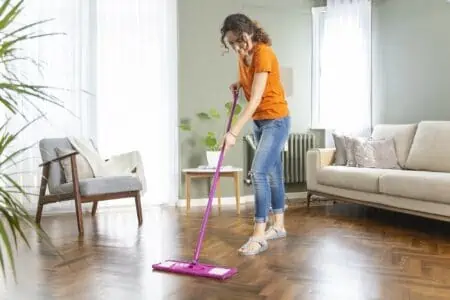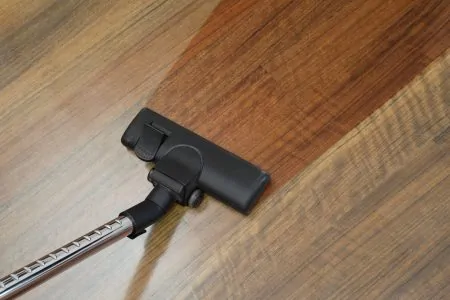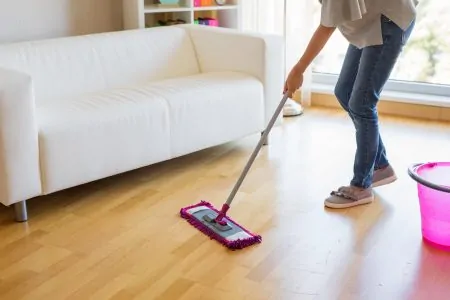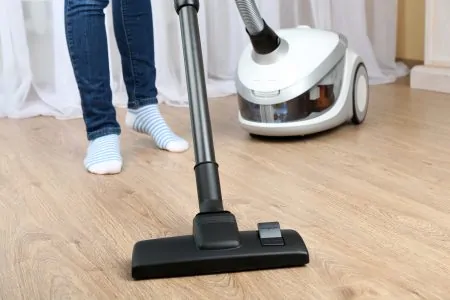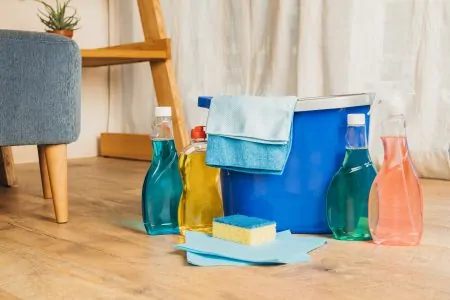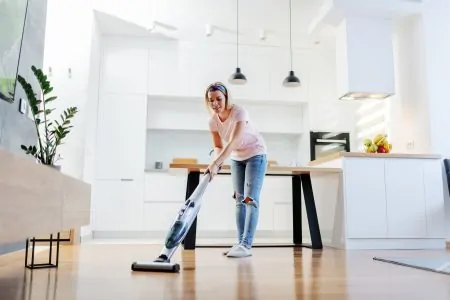People choose laminate flooring because it’s cheap and easy to clean. But stains can still occur, ruining the glazed-donut appearance of laminate.
No matter what kind of stain you’re dealing with, we can help you erase it once and for all. We’ll share how to remove stains from laminate floors using easy and approachable methods.
Whether your day is ruined by a crayon, candle wax, or nail polish stain, we’ve got you covered. Don’t panic. Sit back, relax and get learning!
Key Takeaways
- Use a 1:1 solution of distilled white vinegar and water or a commercial laminate floor cleaner for general cleaning and stain removal.
- For specific stains, like crayon, ink, or nail polish, use rubbing alcohol or acetone to gently remove the stain.
- Avoid abrasive tools, waxes, polishes, ammonia, steam cleaners, and sanders when cleaning laminate flooring.
- Act quickly to clean spills, and use microfiber cloths to prevent scratches and efficiently remove dirt and dust.
What is the Best Cleaner to Use on Laminate Wood Flooring?
You can clean laminate flooring using commercial and natural cleaners. We’ll walk you through our favorite options under both categories.
- PROCARE Citrus Floor Cleaner: This floor cleaner is safe for laminate, tile, marble, and more. It leaves behind a refreshing citrus fragrance and zero streaks. Plus, it’s eco-friendly, so you can happily use it in a pet- and child-friendly home.
- Better Life Dirt Destroying Floor Cleaner: This all-natural floor cleaner is tough on grease and grime. This will remove various stains without leaving a film.
- Bona Hard-Surface Floor Cleaner: This highly-rated cleaner works wonderfully on laminate, stone, and tile. It dries quickly, leaving behind zero residue and, even better, zero stains. Apply it with a spray mop or a squirt bottle for easy application.
- Warm water: Now getting into natural cleaners — sometimes warm water is enough to clean laminate and remove stains. In combination with a microfiber mop, warm water can leave your floors sparkling clean.
- Distilled white vinegar: This natural, non-toxic mild disinfectant can remove odors, add shine and eliminate stains — even rust. If you don’t like the pungent smell of vinegar, you can add a few drops of mild dish soap or lemon juice to the mixture.
- Rubbing alcohol: To remove tough stains and disinfect flooring, rubbing alcohol makes a great DIY floor cleaner. You can even add mild dish soap for extra grease-fighting power.
- Acetone: Cleaning with acetone is excellent for spot-cleaning pen marks, nail polish, permanent marker, tar, and paint.
- Window cleaner: A window cleaner can remove urine, feces, and blood stains.
Avoid abrasive tools, waxes, polishes, ammonia, steam cleaners, and sanders when cleaning laminate flooring.
How to Remove Stains From Laminate Floor
If your floor boasts general dirt, stains, and grime, you can use an all-purpose cleaning method. Here’s how to get stains out of laminate flooring using a commercial cleaner or vinegar.
- Time: 20 minutes.
- Difficulty: Easy.
What You’ll Need
- Vacuum cleaner with a soft attachment or broom and dustpan.
- Microfiber mop.
- Distilled white vinegar or commercial laminate floor cleaner.
- Water.
- Spray bottle or bucket.
- Towel.
1. Vacuum or Sweep the Floors
Before removing stains, it’s crucial to remove dust and debris. If you skip this step, you could create new stains or embed dirt into the laminate.
When vacuuming, make sure you have a soft attachment to avoid scratching the floors. If you’re using a broom, we recommend a soft-bristled, flared broom, which will pick up more dust.
2. Prepare Cleaner
In a large bucket or spray bottle, prepare your vinegar cleaner. Dilute a 1:1 solution of distilled white vinegar and water. Shake well to combine.
If using a commercial product, dilute according to packaging instructions. Some commercial cleaners are pre-measured and ready to use.
3. Mop the Floors
Spray the cleaner over the stained areas. If using a bucket, dip the mop into the solution and wring it out well. Move the mop over the stained area in the direction of the laminate’s grain.
Continue until the stain has lifted. This might take a few minutes.
4. Rinse the Floors
Mop the area with plain warm water to remove the cleaning solution residue.
5. Dry the Floor
Using a towel, wipe the floor dry. Too much moisture can damage laminate flooring, so we never want to leave it wet.
How to Get Stains Out of Laminate Flooring
The above method works for all kinds of general stains. But some stains love to cling to laminate flooring. We’ll walk you through common stubborn stains, dark stains, and light stains and specific cleaning instructions for removing them.
White Water Stains
Water can leave behind unsightly white marks. Removing white water stains is pretty straightforward.
In fact, the above vinegar method will work wonders. Here is another method to try:
- Use distilled water: Dampen a cloth in distilled water and wipe the water stains.
- Dry: Immediately dry the stained area with a soft towel.
- Repeat: Repeat as necessary to remove all evidence of the water spots.
Crayon or Ink Stains
If you have kids or are just an artsy type, crayon and ink stains might be common in your home. Here’s how to erase them:
- Vacuum: Vacuum the area to remove excess dirt and debris.
- Dampen a cloth: Dampen a microfiber cloth with rubbing alcohol. This is a handy solvent that can break up the ink and crayon.
- Rub: Rub at the stain for a few minutes until it starts to lift. You might need to use some elbow grease — you can rest your arms after!
- Rinse and dry: Rinse the area using a cloth dampened in water. Dry the flooring with a soft towel.
Warning
If the stain is caused by liquid ink and the above method doesn’t work, it might have seeped through the flooring’s finish. In this case, you might need to hire a professional.
Greasy Stains
Believe it or not, greasy stains are some of our favorites! The correct method makes it so easy to remove sticky, oily spots. You can use the vinegar cleaning method — just add some dish soap for extra grease-fighting power.
But there is another fun hack that works wonders. Try this:
- Get some ice: Put some ice cubes in a plastic bag and place it over the stain.
- Wait: Give it 10 minutes to freeze the grease.
- Scrape: Scrape the hardened grease from the floor using a putty knife or credit card.
- Clean: Wipe the area with a microfiber cloth dipped in warm water and dish soap.
- Rinse: Wipe the area again with a microfiber cloth dipped in plain water.
- Dry: Dry the area with a soft towel.
Candle Wax Stains
Our laminate floor stain removal guide wouldn’t be complete without mentioning a candle wax stain. We’ll show you how to remove the excess wax and the lingering stain.
- Wait: Wait until the candle wax has hardened. It will be easier to remove.
- Scrape: Scrape the excess wax up with a plastic putty knife or credit card.
- Prepare cleaner: In a spray bottle, combine a 1:1 solution of distilled white vinegar and water.
- Spray: Spray the cleaner onto a microfiber cloth and wipe the stain, enforcing some elbow grease until the stain has lifted.
- Rubbing alcohol: If the stain remains, apply a little rubbing alcohol onto a soft cloth and scrub at the stain until it lifts.
- Rinse: Rinse the area with plain water.
- Dry: Dry the area with a soft towel.
Coffee or Wine Stains
Organic stains, like coffee and wine, don’t need to be a forever part of your home. Here’s how to remove them from the laminate:
- Clean the excess: As soon as possible, absorb the liquid with a clean paper towel or old cloth.
- Create cleaner: Pour a 1:1 solution of vinegar and water into a spray bottle.
- Spray: Spray the cleaner onto the stain and wipe it away with a paper towel or microfiber cloth.
- Rinse: Rinse the area with plain water.
- Dry: Dry the area with a soft towel.
Scuff Marks
Scuff marks are pretty hard to remove, and they can’t be 100 percent eradicated. But there are a few hacks that can help minimize the appearance of scuff marks.
- Grab a tennis ball: Find a clean tennis ball.
- Cut: Cut an “X” shape into the tennis ball and stick it on the end of a broom handle.
- Buff: Gently buff the scuff mark using the tennis ball.
- Create a paste: If the scuff mark remains, make a baking soda paste with warm water.
- Apply: Apply the paste to the scuff mark with a microfiber cloth. Rub gently until the scuff mark either disappears or looks less obvious.
- Rinse: Wipe the area with a microfiber cloth dipped in plain water to remove the paste residue.
- Dry: Dry the area with a soft towel.
Nail Polish Stains
Next time you spill nail polish on a laminate floor, don’t scream. Just follow these steps:
- Remove excess: Remove excess by scooping the nail polish with a paper towel. Don’t smear it around; try to scoop it up with a paper towel.
- Apply acetone: Pour acetone onto a paper towel or cloth. Repeat the scooping motion to remove the nail polish stain.
- Repeat: Repeat the above steps, but this time move in a swiping motion to get into the laminate grooves and textured spots.
- Continue: Continue until all nail polish is removed.
- Use rubbing alcohol: If the stain persists, dampen a cloth or paper towel with rubbing alcohol and lay it over the stain. Leave it for a few minutes before wiping the area. This should remove the rest of the stain.
- Rinse: Rinse the area with a damp cloth.
- Dry: Dry the area with a soft towel.
Furniture Polish Stains
You shouldn’t use furniture polish on laminate. But if you spilled some after oiling up your vintage table, then here’s how to remove it:
- Sprinkle cornstarch: Sprinkle cornstarch over the area and leave it on for 10 minutes.
- Buff: Buff the area with a dry cloth.
- Vacuum: Vacuum or sweep the cornstarch away.
- Create vinegar cleaner: Combine equal parts distilled white vinegar and water in a spray bottle. Add a few drops of dish soap.
- Apply: Spray a cloth with the cleaner and wipe the stained area. Continue until the polish has lifted.
- Dry: Wipe the area with a dry towel to remove excess liquid.
- Rinse and dry: Rinse the area with plain water and dry again, leaving the floors void of moisture.
Glue Stains
Glue can be hard to remove. We will start with a gentle approach, but if that doesn’t work, we will move to something stronger. The only thing to note is that the stronger the cleaning method, the more likely it is to cause a little damage to the laminate.
- Make a vinegar spray: Mix ¼ cup of vinegar per four cups of warm water. Pour it into a spray bottle.
- Spray the area: Spray this generously over the glue and leave it for one minute.
- Wipe: Wipe the area with a dry towel. Repeat the above steps if necessary.
- Apply rubbing alcohol: If the vinegar didn’t remove all the glue residue, pour rubbing alcohol onto a clean cloth. Rub the glue stains — don’t be afraid to apply some elbow grease. Reapply rubbing alcohol as necessary.
- Try Goo Gone: The last thing you can try is Goo Gone. If you use it correctly, it won’t damage your flooring. Apply it directly to the stain and leave it on for five minutes before wiping it away. Then wash the area with hot soapy water.
- Rinse: Rinse the area with plain water.
- Dry: Dry the area with a soft cloth.
Hair Dye
If you use laminate flooring in your bathroom or salon, hair dye might be a common stain you need to tackle. Arm yourself with the proper knowledge and try this method:
- Use Mr. Clean Magic Eraser: Yep, you heard us right. This handy little sponge can remove hair dye. Dampen the eraser and rub it over the stain.
- Make a paste: If the stain remains, make a thick paste using baking soda and distilled white vinegar.
- Apply: Apply the paste to the stain for 15 minutes.
- Wipe: Remove it with a clean microfiber cloth.
- Repeat: Repeat if necessary.
- Rinse and dry: Rinse the area with plain water and dry with a soft towel.
Tips and Tricks For Laminate Floor Stain Removal
You know how to get stains out of laminate flooring. But to make the most of your laminate flooring, arm yourself with as much knowledge as possible. Here are some extra tips and hacks for you to memorize:
- Use microfiber: While you can use cotton or linen rags, we recommend microfiber. Microfiber creates static electricity, which can remove more dirt and dust. Plus, it’s soft and non-abrasive on your floors.
- Vacuum and mop weekly: Vacuum your laminate floors once or twice a week. This will prevent stain buildup. We also recommend dry or wet mopping your laminate floors once a week to remove buildup.
- Choose a waterless cleaner: When choosing a commercial product for regular use, choose one made without water. This means it’s rinse-free, saving you time and hassle. You can’t leave water-based products on laminate flooring for too long as it can warp the flooring.
- Avoid these products: Don’t use the floor polish, wax, or oil soap on laminate. This leaves behind a dull film.
- Act fast: When you spill something on laminate, clean it up as soon as possible. Otherwise, it can get into the laminate cracks, leaving behind stubborn stains.
- Dab, don’t wipe: When cleaning spills, dab, don’t wipe. This will prevent you from pushing the spill around, further embedding it into the flooring.
- Avoid abrasive cleaners: Don’t use abrasive sponges or steel wool to clean stains from laminate. This will scratch your floors.
- Say no to steam: Steaming a laminate floor can add shine, but it shouldn’t be part of your regular cleaning routine. If you need to use it, don’t do it more often than every other month.
